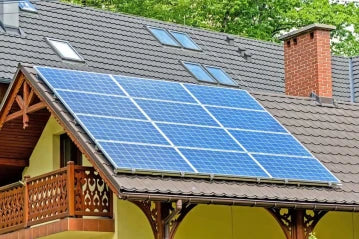
Harnessing solar energy has become increasingly popular, and for good reason. Not only does it offer environmental benefits, but it also allows homeowners and businesses to reduce their reliance on conventional energy sources while potentially saving on utility bills. As the demand for solar energy products rises, so does the need for efficient and effective solar inverters. In this blog, we'll explore the advantages of multiple Maximum Power Point Trackers (MPPTs) in inverters, highlighting why they are a superior choice for optimizing solar power generation.
What is an MPPT?
Before diving into the benefits of multiple MPPTs, let's briefly understand what an MPPT is. The Maximum Power Point Tracker is a critical component in a solar power system. Its primary function is to ensure that the solar panels operate at their maximum power output. Solar panels generate electricity based on sunlight exposure, and the amount of power produced depends on the environmental conditions. The MPPT's role is to continually track and adjust the electrical load to match the changing conditions, ensuring that the panels operate at their peak efficiency.
What is Dual MPPT?
Traditionally, most inverters have been designed with a single MPPT. However, as solar technology advanced, manufacturers introduced inverters with multiple MPPTs. Dual MPPT, as the name suggests, employs two separate trackers to optimize energy production. Each MPPT is connected to a specific set of solar panels, allowing them to operate independently. This innovative technology has paved the way for even greater advantages in solar energy systems.
Dual MPPT Vs. Single MPPT - Which is Better?
The debate between dual and single MPPT often leaves potential solar energy consumers pondering which option is superior. While both have their merits, the choice boils down to specific requirements and system design. Let's briefly explore the differences:
1. Efficiency: Dual MPPT inverters are more efficient in situations where the solar panels have varying orientations or are subject to shading. By operating independently, each MPPT optimizes its connected panel set, preventing the underperformance of shaded panels from affecting the output of unshaded panels.
2. Flexibility: For installations with multiple arrays of solar panels facing different directions or mounted on separate roof sections, dual MPPT inverters offer unmatched flexibility. They can accommodate diverse configurations, making them ideal for complex installations.
3. System Monitoring: Dual MPPT systems allow for better system monitoring and diagnostics. The independent tracking of each array permits more precise monitoring of individual panel performance, simplifying troubleshooting and maintenance.
4. Expansion: In cases where future expansion is anticipated, dual MPPT inverters offer a distinct advantage. They can easily accommodate additional solar panels by connecting them to the available MPPT inputs without affecting the existing setup.
5. Cost Considerations: While dual MPPT inverters may provide more advantages in specific scenarios, they can be slightly more expensive than single MPPT counterparts. For simpler installations with uniform solar panel setups, a single MPPT inverter might be a more cost-effective choice.
What are the Advantages of Multiple MPPTs in an Inverter?
Now that we've explored the differences between dual and single MPPT inverters, let's delve into the significant advantages of multiple MPPTs in solar inverters:
1. Increased Energy Yield: The primary advantage of multiple MPPTs is the significant increase in energy yield. As mentioned earlier, dual MPPT inverters can efficiently optimize energy production even in situations with shading or panels facing different orientations. By capturing the maximum power available from each panel set, the overall energy yield is substantially improved.
2. Enhanced System Flexibility: Flexibility is a key factor in any solar energy system. Multiple MPPTs allow for greater system design flexibility, accommodating various solar panel configurations. Whether you have different types of solar panels or arrays with different angles, a multiple MPPT inverter can adapt to the unique requirements of your installation.
3. Better Performance Monitoring: Detailed performance monitoring is crucial for evaluating the effectiveness of a solar power system. Multiple MPPTs enable more granular monitoring, as you can track the performance of each array separately. This level of insight empowers users to identify and address any issues promptly, leading to improved system performance and reduced downtime.
4. Optimal Use of Available Space: For installations with limited roof or ground space, maximizing energy production per square foot is essential. Multiple MPPTs help make the most of the available space by ensuring that each solar panel set operates at its highest efficiency.
5. Future Expansion: As solar energy needs evolve, having the option to expand your system is valuable. Multiple MPPT inverters make it easier to incorporate additional solar panels into your existing setup, simplifying the process of system expansion.
6. Increased Reliability: In the case of a fault affecting one MPPT, the other MPPT(s) can continue to operate without any significant impact on overall system performance. This redundancy enhances the overall reliability of the solar power system.
Conclusion
When considering a solar energy system, the choice of inverter is crucial to ensure optimal energy generation and long-term performance. Multiple MPPT inverters, particularly dual MPPT, offer significant advantages over single MPPT options. The increased energy yield, system flexibility, and better monitoring capabilities make them an attractive choice for a wide range of installations.
While dual MPPT inverters may have a slightly higher upfront cost, the benefits they provide in terms of energy efficiency and adaptability can lead to greater savings and long-term returns on investment. As the solar industry continues to evolve, multiple MPPT inverters stand as a beacon of efficiency and sustainability for those looking to harness the full potential of solar energy.


0 Kommentare